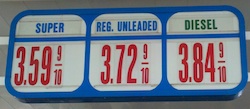According to new analysis conducted by Informa Economics, Inc., ethanol costs significantly less than gasoline at the wholesale level and is reducing pump prices for consumers across the country. The report demonstrates that the Renewable Fuel Standard (RFS) and its associated “RIN” credits, have not been a factor in this spring’s higher retail gasoline prices. A RIN is a Renewable Identification Number that is used to track the use of biofuels by obligated parties.
“A fact-based review of developments in the gasoline, ethanol and RIN markets indicates that the Renewable Fuel Standard in general and RINs in particular have not been a demonstrable factor in the rise in retail gasoline prices that has occurred in early 2013,” the report concluded.
 Responding to the independent study’s findings, Renewable Fuels Association (RFA) President and CEO Bob Dinneen said, “Not surprisingly, opponents of the RFS have absurdly suggested RINs are a reason for this spring’s higher gas prices. This report puts that silly notion to rest and clearly confirms that RINs are not having any noticeable impact on gasoline prices. In fact, as the Informa analysis plainly shows, increased ethanol use leads to lower—not higher—prices at the pump for American consumers. The facts and data speak for themselves. Drivers could realize even greater savings at the pump if refiners and blenders would break down their self-inflected blend wall and give up their stubborn resistance to offering E15 and E85.”
Responding to the independent study’s findings, Renewable Fuels Association (RFA) President and CEO Bob Dinneen said, “Not surprisingly, opponents of the RFS have absurdly suggested RINs are a reason for this spring’s higher gas prices. This report puts that silly notion to rest and clearly confirms that RINs are not having any noticeable impact on gasoline prices. In fact, as the Informa analysis plainly shows, increased ethanol use leads to lower—not higher—prices at the pump for American consumers. The facts and data speak for themselves. Drivers could realize even greater savings at the pump if refiners and blenders would break down their self-inflected blend wall and give up their stubborn resistance to offering E15 and E85.”
The analysis, commissioned by RFA, found RINs are likely contributing no more than $0.004 (four-tenths of one cent) to the retail price of a gallon of gasoline. Meanwhile, ethanol’s wholesale discount to gasoline in 2013 has reduced the pump price for blended gasoline by an average of $0.044 per gallon. Thus, when the net impact of both RIN costs and ethanol’s discount to gasoline are considered, ethanol-blended gasoline is saving consumers an average of $0.04 per gallon based on straight blending economics.
“Considering both the ethanol price advantage and the direct cost of RIN prices, the net benefit to consumers from the usage of ethanol is $0.04 per gallon of gasoline…” the report found. According to the authors, this savings doesn’t take into account either the indirect benefit that ethanol has on gasoline prices by effectively lowering demand for crude oil and clear gasoline or the enhanced octane value of ethanol over gasoline.
High gasoline prices in early 2013 can be explained by several factors unrelated to the RFS, RINs, or ethanol use, the report found. “There is a distinct seasonal pattern to gasoline prices and crack spreads,” the analysis notes, adding that “[t]he increase in gasoline prices and crack spreads during the first quarter of 2013 has been generally consistent with increases experienced in 2011 and 2012, despite the fact that conventional ethanol RIN prices averaged $0.03 during the first quarter of 2011 and $0.02 during the first quarter of 2012.” Citing a Department of Energy analysis, the Informa report also notes that higher gasoline prices have stemmed from planned and unplanned refinery maintenance; the low starting level for gasoline crack spreads going into 2013; preparation for seasonal fuel specification changes; and developments in global product demand.
The report was discussed during a media teleconference call that you can listen to here: rfa-rinteleconference-13.mp3

